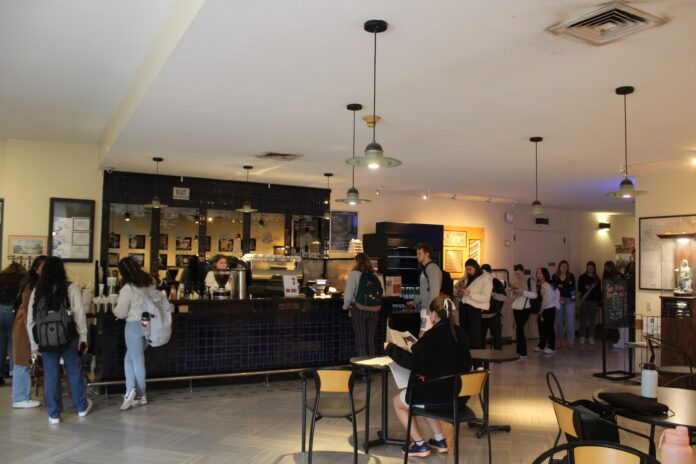
As temperatures drop and the university migrates indoors, reliable infrastructure on the University of Dallas campus becomes increasingly important to students’ lives. Temperatures in Irving dipped near freezing toward the end of October, shocking students in older dorms that had not switched over to their heating systems.
Benjamin Gibbs, assistant vice president for operations, explained why older buildings cannot immediately react to stark climate changes.
“While many of the newer buildings on campus have a ‘four pipe’ system that allows for the running of both cold and hot air, some older buildings, such as Gregory Hall, Madonna Hall and Gorman Lecture Center, operate on a ‘two pipe’ system, which means they run cold air or hot air but need to be switched back and forth during seasonal changes. Older campus buildings are, in effect, switched over to heat after sustained colder temperatures arrive in November/December and switched back in the spring,” Gibbs said.
Facilities employees remain vigilant and aware of this transition.
“Facilities team members are always available to respond to student or faculty/ staff work requests if a system or unit is not functioning properly,” Gibbs said.
Dr. John Norris, associate provost, went into further detail about Facilities’ reasoning when switching from air conditioning to heat.
“The level of difficulty in these old systems at changing everything over is such that the time expense – and I believe the financial expense – is such that we try to do it once a semester,” said Norris.
These limitations affect university campuses nationwide and are not unique to UD.
“The reality is that if you go to colleges across the country – just about any place that has dormitories that were built before the 1950s – you’ll find a lot of them have some advantages from having been built before in terms of size of rooms, and they will sometimes have disadvantages in terms of heating and air conditioning systems,” said Norris.
Gibbs reaffirmed the university’s commitment to reevaluating the needs of the campus and improving climate conditioning where possible.
“While there is not an immediate solution to transition more campus buildings to a ‘four pipe’ system, university leaders are constantly evaluating the campus and its physical plant needs and trying to plan for future upgrades that create and maintain comfortable spaces for study, worship, work, and play,” said Gibbs.
On Friday, Sept. 15, Dr. Jonathan Sanford, president, announced during his State of the University address that plans have been made to renovate the Haggar University Center. Commissioned by Aramark, the project plans to expand the building by relocating office space and improving the first-floor amenities.
“Aramark had approached us with the possibility of making a significant capital investment in the university in exchange for extending their contract,” said Sanford. This proposal is currently under consideration.
Gibbs credits the collaborative input of the entire university for the current renovation roadmap.
“The genesis of the project started several years ago under President Sanford’s leadership and began to accelerate about a year ago. We collected extensive survey and focus group feedback from students, faculty and staff, including conversations with Student Government, and used that data to start to plan for some upgrades in Haggar University Center,” Gibbs said.
The renovation seeks to target areas of importance to student life, but also implement improved logistics to better optimize UD’s central building.
“There are certainly some elements [of Haggar] that are not ideal,” said Norris. The haphazard relocation of the Drama Department’s practice rooms, the Office of Student Affairs and Campus Ministry were examples provided by Norris.
“The university is going to be working with Student Affairs, Student Government, faculty and staff in this process of renovation, in consultation with architects, to try to utilize the space not only more efficiently, but with a greater sense of integrity of the purpose of the building as a student center,” Norris said.
This renovation project, if brought to fruition, will usher in improvements to Haggar’s first-floor amenities, most notably the Cap Bar.
“We received a lot of feedback regarding the importance of the Cap Bar, including its central location in Haggar, student baristas, low prices, Italian aesthetic and setup as a place to gather and be in community together,” said Gibbs. “A key piece of a potential renovation could be to keep the Cap Bar in its location but renovate areas near it, including expanding areas for students to study and be in community together, increasing food options and improving lighting and power access.”
“I want to move the bookstore, because it takes up so much space,” said Sanford. “That wall that overlooks the balcony might become windows and doors, so people can go in and out and have places to sit.”
A key priority in renovating the Cap Bar is shortening the line, a point Gibbs and Norris both corroborated.
While the negotiations with Aramark are not fully set in stone, the project may still materialize in a few months.
“These renovations could start as early as Summer 2024 and extend into 2025, depending on the final scope of the project,” said Gibbs.